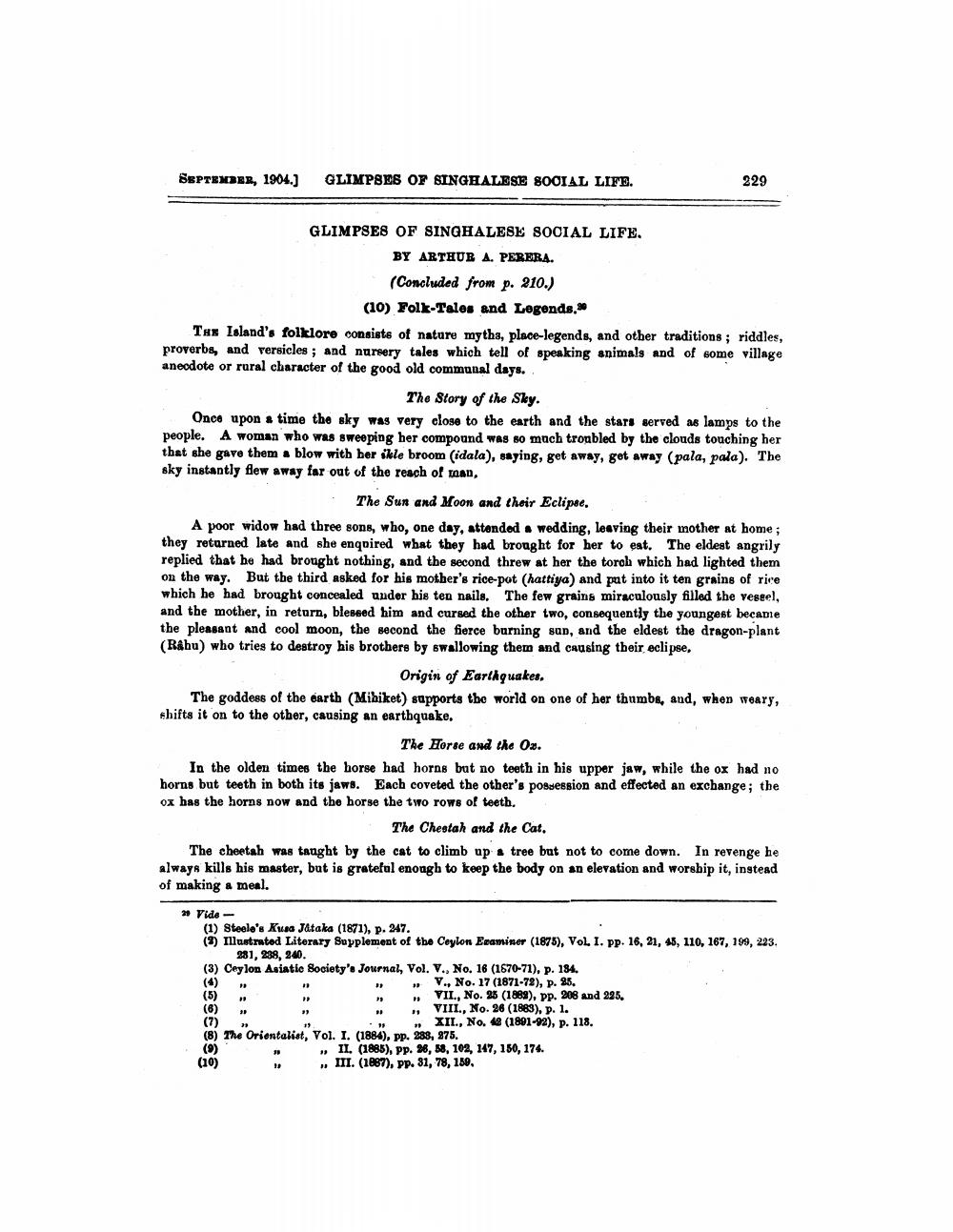________________
SEPTEMBER, 1904.]
GLIMPSES OF SINGHALESE SOCIAL LIFE.
BY ARTHUR A. PERERA.
(Concluded from p. 210.)
(10) Folk-Tales and Legends,90
THE Island's folklore consists of nature myths, place-legends, and other traditions; riddles, proverbs, and versicles; and nursery tales which tell of speaking animals and of some village anecdote or rural character of the good old communal days.
The Story of the Sky.
Once upon a time the sky was very close to the earth and the stars served as lamps to the people. A woman who was sweeping her compound was so much troubled by the clouds touching her that she gave them a blow with her ikle broom (idala), saying, get away, get away (pala, pala). The sky instantly flew away far out of the reach of man,
The Sun and Moon and their Eclipse.
A poor widow had three sons, who, one day, attended a wedding, leaving their mother at home; they returned late and she enquired what they had brought for her to eat. The eldest angrily replied that he had brought nothing, and the second threw at her the torch which had lighted them on the way. But the third asked for his mother's rice-pot (hattiya) and put into it ten grains of rice which he had brought concealed under his ten nails. The few grains miraculously filled the vessel, and the mother, in return, blessed him and cursed the other two, consequently the youngest became the pleasant and cool moon, the second the fierce burning sun, and the eldest the dragon-plant (Rahu) who tries to destroy his brothers by swallowing them and causing their eclipse,
Origin of Earthquakes,
The goddess of the earth (Mihiket) supports the world on one of her thumbs, and, when weary, shifts it on to the other, causing an earthquake.
GLIMPSES OF SINGHALESE SOCIAL LIFE.
The Horse and the Ox.
In the olden times the horse had horns but no teeth in his upper jaw, while the ox had no horns but teeth in both its jaws. Each coveted the other's possession and effected an exchange; the ox has the horns now and the horse the two rows of teeth.
29 Vide
The Chestah and the Cat.
The cheetah was taught by the cat to climb up a tree but not to come down. In revenge he always kills his master, but is grateful enough to keep the body on an elevation and worship it, instead of making a meal.
e
(1) Steele's Kusa Jataka (1871), p. 247.
(3) Illustrated Literary Supplement of the Ceylon Examiner (1875), Vol. I. pp. 16, 21, 45, 110, 167, 199, 223. 281, 238, 240.
(3) Ceylon Asiatic Society's Journal, Vol. V., No. 16 (1870-71), p. 134.
(4)
"
"
(5)
33
(6)
"
(7)
(10)
229
39
"
"
"
V., No. 17 (1871-72), p. 25. "VII., No. 25 (1888), pp. 208 and 225,
,, VIII., No. 26 (1883), p. 1.
XII., No. 42 (1891-92), p. 118.
"5
The Orientalist, Vol. I. (1884), pp. 233, 275.
"1
II. (1885), pp. 26, 58, 102, 147, 150, 174. " III. (1887), pp. 31, 78, 150.




